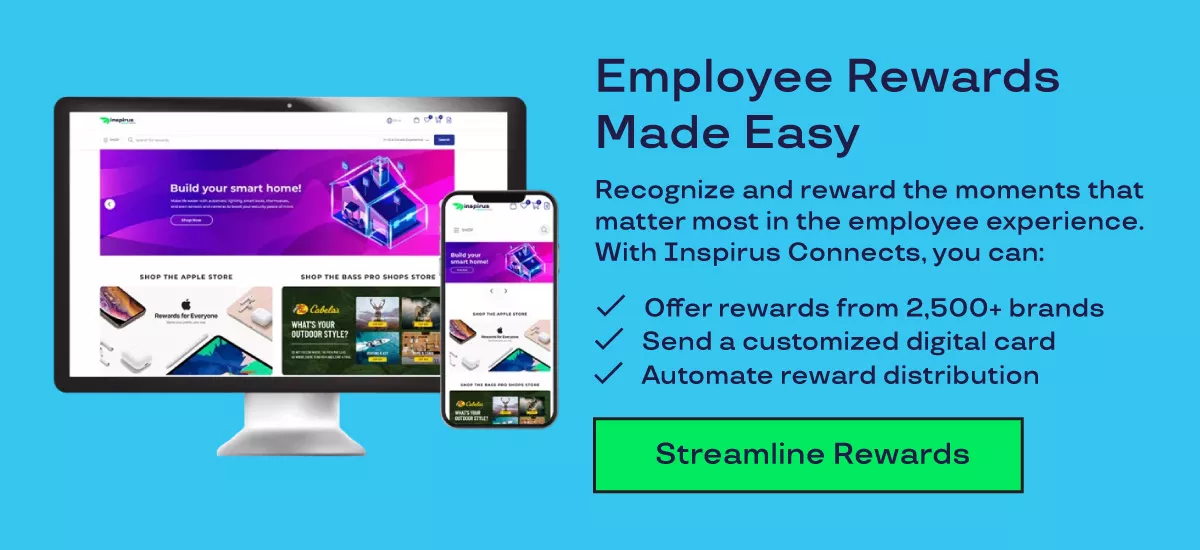
The Difference Between Employee Rewards and Employee Perks
May 8, 2024
Employee perks and employee rewards are an equally important part of benefits and compensation. Learn the key differences between the two and how they can be used together.
There are two key parts of every employees' compensation package: employee perks and employee rewards. These two components go hand in hand in creating a more enriching employee experience that acknowledges important milestones, improves employee satisfaction, and supports employee well-being.
In this blog post, we discuss the differences between employee perks and rewards and share common examples of each.
Understanding Employee Benefits
Employee benefits are an essential part of employees' compensation package. As Forbes defines it, "Employee benefits are compensation packages that include extras such as health insurance, retirement savings plans, paid vacation days and more." These benefits include a wide range of non-compensation offerings provided by employers beyond base salary or wages.
Examples of employee benefits include:
- Health insurance
- Retirement plans
- Paid time off
- Parental leave
- Tuition reimbursement
It's important to note that some benefits are legally mandated. To name a few, social security, Medicare, and unemployment insurance are required federally in the United States.
However, organizations will add additional benefits, such as employee perks and rewards, to help attract and retain valuable employees. For instance, companies like Google, Deloitte, Meta, and Netflix are well known for their above and beyond benefits, which have made them highly sought-after by job seekers.
What are employee perks?
Employee perks are additional privileges or amenities offered by employers to enhance the workplace experience and improve employee satisfaction. Unlike benefits, which are often mandated by law or industry standards, perks are discretionary and vary widely between organizations.
Offering these additional benefits can help companies create a more engaging and satisfying workplace experience for their staff -- improving job satisfaction and retention.
Examples of Employee Perks
As shown, employee perks are a key factor in enhancing the employee experience and elevating employee satisfaction. Here are some common examples that organizations may offer to their workforce:
- Flexible work arrangements
- Sabbaticals
- Commuter benefits
- Professional development opportunities
- Workplace services
For additional examples, check out this guide, which explores 25 innovative perks that employees love.
What are employee rewards?
Employee rewards are a form of recognition and incentives given to employees for their contributions and achievements within an organization. Unlike perks, which are ongoing benefits, rewards are typically granted on a merit basis or as part of a structured incentive program.
These rewards can be used to highlight important moments throughout the employee experience – making it a more meaningful and enriching experience for employees.
Examples of Employee Rewards
Employee rewards can be presented to staff for both performance-based achievements and for general appreciation. Organizations may offer their staff rewards for the following scenarios:
- Professional achievements
- Service anniversary and employee milestones
- Special occasions (i.e. holidays, Employee Appreciation Day, etc.)
- Behavior-based awards such as Employee of the Month and Employee of the Year
For additional employee reward ideas and examples, check out this blog.
A key part of rewarding employees is the incentive options organizations offer to their employees. Each employee has vastly different expectations and preferences, so it's important that your rewards suit each of their needs. For example, the Incentive Research Foundation recently conducted a survey that revealed gift cards are one of the most preferred reward types, even over cash.
Here are a few examples of traditional rewards organizations often offer:
- Gift cards
- Company swag
- Merchandise
- Tickets and events
- Bonuses or cash
- Charitable donations
If you are unsure what rewards your employees prefer, an easy way to get their opinions is by sending out an employee feedback survey, which tools like The Happiness Index can help with.
Additionally, there are also digital recognition platforms available that can help streamline employee rewards programs, like Inspirus Connects Celebrates. These platforms enable you to send rewards en masse with little to no hassle.
Tying It Together
Employee perks and rewards are essential components of the employee experience. Employee perks are a great solution for enhancing workers' day-to-day experience and supporting employee well-being. Employee rewards, on the other hand, are effective for building a culture of appreciation and enhancing major milestones in the employee experience. Combined, these two benefits can help organizations create a meaningful employee experience, elevate employee satisfaction, and attract top talent.
If you want to elevate your employee experience, we can help. With over 130 years of experience, our specialists can create a digital rewards programs tailored to your organization's specific needs. Talk with an Inspirus specialist today to learn more!





